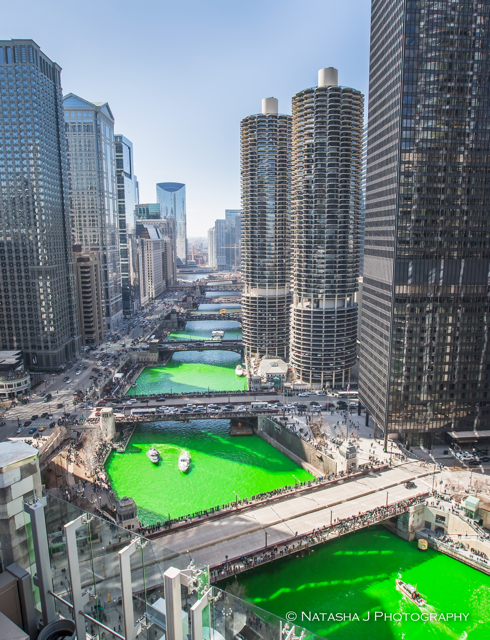St. Patrick’s Day
Natasha Jelezkina from Chicago, USA is licensed under CC BY-SA 2.0
THE WORK OF THE LEPRECHAUNS: Have you ever wanted to visit Chicago on Saint Patrick’s day? If you do, it will undoubtedly be one of the coolest yet most interesting sights ever! Every year on March 17, Chicago dyes their river green! In 1961, Stephen Bailey, a plumber noticed that his friend had bright green stains (associated with the flag color of Ireland) all over his white overalls. Then, the mayor of Chicago at the time discovered where the sewage in the water was originating from and used the green dye to help the source of the leaky pipes. In 1962, the local plumbers union decided to use that 100 pounds of dye to turn the river green for Saint Patrick’s Day! This year will be the 61 year anniversary of dying the river green!
When you think of Saint Patrick’s Day, many things may come to mind, such as gold, leprechauns, and rainbows. Although some of these symbols relate to the history behind the holiday, the original background of Saint Patrick and the purpose of the traditions go deeper than that.
Saint Patrick’s Day is actually a religious and cultural celebration commemorating the feast day of Saint Patrick. Patrick was a 5th century Christian missionary and Bishop in Ireland. He was allegedly kidnapped and brought to Ireland as a slave when he was just 16 years old. He escaped from slavery after being given orders in a dream from God to flee to the coast, where a ship would be waiting to take him home to England. Because Patrick was allowed to come back to England, he started believing in Christ and became a priest where he could spread the word of God. It was not long before he went back to Ireland to spread Christianity. Saint Patrick influenced many people to convert to Christianity throughout Ireland and England. After his death, the Church named him the Patron Saint of Ireland and honored him with a feast day on March 17.
While the color green is synonymous with the holiday now, it was not until 1798, the year of the Irish Rebellion, that the color green became officially associated with the day. Up until the rebellion, the color associated with St. Patrick was actually blue, as it was featured both in the royal court and on ancient Irish flags. While the British wore red, the Irish chose to wear green during the rebellion, and this cemented the color’s relevance in Irish history. It also is customary for people to wear green on St. Patrick’s Day because of the holiday’s association with Ireland’s nickname, the “Emerald Isle.” Following tradition, you get pinched on St. Patrick’s Day for not wearing green because according to folklore, green makes you invisible to leprechauns.
One of the most common symbols of St. Patrick’s Day is the leprechaun. Belief in leprechauns likely stems from Celtic belief in fairies, which are tiny men and women who use their magical powers to serve good or evil. According to Irish lore, capturing these small creatures will secure the captor a little bit of luck, in addition to three wishes. Another common symbol of the holiday is the shamrock. The shamrock was considered a sacred plant in ancient Ireland because it symbolized the rebirth of spring. By the 17th century, the shamrock had become a symbol of emerging Irish nationalism. As the English began to seize Irish land, many Irish began to wear the shamrock as a symbol of their pride in their heritage and their displeasure with English rule.
Today, more than 200 countries celebrate Saint Patrick’s Day. These celebrations mostly involve parades, parties, wearing green, and traditional Irish meals like corned beef and cabbage.
There are many different traditions in the U.S. and around the world to commemorate St. Patrick’s Day. In Portland, Maine, locals have a Paddy’s Day Plunge which involves jumping into the freezing Atlantic Ocean at 5:30am. There are many cities that dye their waterways or landmarks green for St. Patrick’s Day. Chicago’s green river is one of the most famous examples of this. Every year, the Chicago River turns green just in time for a parade held on the closest Saturday to the holiday. In Brussels, Belgium, people honor the saint by playing Irish sports such as Gaelic football and hurling, and even hold a St. Patrick’s Day Ball. Banwen, Wales has laid claim to being St. Patrick’s birthplace, and the city ritualizes it annually by holding a parade that culminates at a stone commemorating the saint’s alleged birthplace.
Saint Patrick’s Day is a holiday that is celebrated all around the world. It is a day filled with honoring Irish heritage, wearing green, mythical creatures like leprechauns, rainbows, and shamrocks, but most importantly it is a day that honors Saint Patrick and his life.
Your donation will support the Student Publications Department at Mater Dei High School. Your contribution will allow us to keep our equipment up to date and cover our annual website hosting costs.





![WORK TO SUCCEED By working these tips into their study schedule, students can reap the benefits of AP courses. With just a few easy lifestyle changes, and new methods before the test, students can see an increase in scores that other successful students have witnessed. “It‘s really about making sure that throughout the year you know what you're doing,” senior Angela Karanja said. “[Also] being calm the day of, so that you can remember everything that you learned [is helpful].” Infographic by Ava Gomez.](https://thescarletscroll.com/wp-content/uploads/2025/03/IMG_5210-600x338.jpeg)
![A YEAR IN REVIEW
Between Nov. and Dec. 2024, 57 respondents voted for their favorite songs, artists, and albums. Every category had multiple options, and each one faced tight competition as the artists Sabrina Carpenter, Kendrick Lamar, and Billie Eilish battled for the top spots. Students like senior Payton Bauer encourages others to check out other popular singers, if they haven’t already. “I would say [listen to Carpenter] if you're [wanting to] feel good about yourself,” Bauer said. “Or maybe you just want something to work out or dance to. [Her music is] really fun.”](https://thescarletscroll.com/wp-content/uploads/2025/02/Orange-Black-Why-Vinyl-Records-Rock-Music-Infographic-e1738774839991.png)


John • Oct 23, 2023 at 9:03 pm
Yay, St. Patrick’s Day